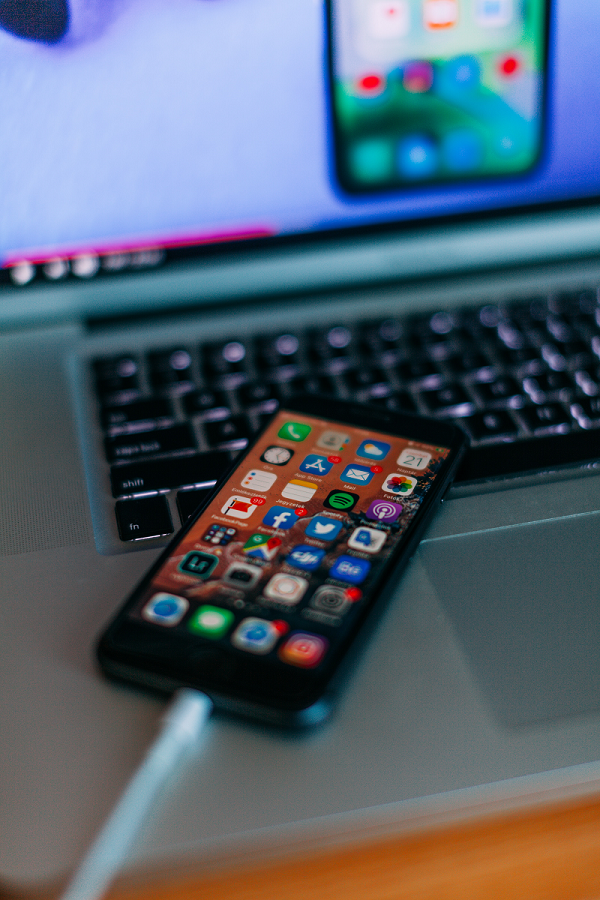What is digital health?
Good question. Downloading an app to track your mood, having a video visit with a therapist, or learning coping skills from a web-based therapy program, are all examples of digital health.
But how can digital health be used to improve overall mental health? Can it help treat mental illnesses such as depression or anxiety?
Jan Lindsay, Ph.D., associate professor of psychiatry, Julianna Hogan, Ph.D., assistant professor of psychiatry, and Alexandra Caloudas, Ph.D., postdoctoral fellow, all at Baylor College of Medicine, discuss how digital health interventions work in the following Q&A.

Q: How can digital health interventions help treat chronic mental illness?
A: Digital health is an umbrella term that can cover almost any kind of communication technology applied to healthcare settings. In behavioral health, this refers to methods of connecting patients to mental healthcare through self-monitoring, communicating with providers (directly or indirectly), and learning new information or skills using technology.
In addition to smartphone apps, telehealth, and online therapy programs, other examples of digital health include virtual reality interventions, therapeutic video games, and interventions implemented using artificial intelligence (AI). There are more than 10,000 mental health apps, and the area of digital mental health continues to evolve and expand.
Q: What are some common digital health interventions?
A: Digital health is typically used to address some sort of gap in access to care. People who experience barriers to physically getting to a clinic for behavioral or mental health may be able to access mental healthcare through digital health.
In addition to individual barriers, systemic barriers also exist, including a shortage of providers and societal stigma associated with mental health concerns. The prevalence of mental health concerns has significantly increased since the beginning of the COVID-19 pandemic, creating a potential for greater demand. With more than 225 million people in the U.S. having access to a mobile device, digital health seems uniquely suited to bridge this barrier to care.
Q: How do you know what types of digital health are trustworthy?
A: It can be hard to tell sometimes. This is a good conversation to initiate with your provider, if you are already connected with one. Often, if someone is engaged in behavioral or mental health care, the provider can help vet and recommend different digital health tools that might be relevant to that individual’s goals and concerns.
You may wonder, “How do I know what’s good and what’s not?” Digital health literacy refers to the steps a person can take, as a consumer, to critically evaluate apps and other health tools. Not all digital health tools for mental health are created equally, so a group from Harvard University led by Dr. John Torous put together a series of steps that show how consumers can evaluate apps, as well as an updated list of apps that their team has vetted.
Another helpful resource is the One Mind Psyber Guide. This provides information, reviews, and ratings to help consumers make decisions about which apps to use. The American Psychiatric Association also has an online tool, the APA’s App Advisor, that can help providers critically evaluate available apps for mental health. Make sure you’re also informed on digital data privacy, policies and protections.
Q: How can digital health become more accessible?
A: While access to digital health tools is increasing, there are still many populations that are left behind. For example, recent survey data from Accenture found that 43% of millennials have trust in tech companies who provide health and wellness services compared to 14% of baby boomers.
These types of beliefs, in part, may help explain why younger patients may opt more readily for digital health tools. When implementing digital health interventions with older populations, some older adults may need additional support to cross the digital divide.

Access to digital mental health interventions also varies by race and ethnicity. One study reported that older adults who identified as Black or Hispanic were less likely than whites to use technology for health information or management. One recent study reported that while 68% of white Americans had frequent access to internet, only 38% of African Americans and 42% of Hispanic Americans had frequent internet access. Future efforts to implement interventions should examine and work toward reducing and eliminating these access barriers.
Q: Is digital health effective?
A: Yes! Although there is strong evidence to support digital mental health, it is important to note that there is wide range of interventions.
For example, some interventions are designed to be self-guided, while others are used as an adjunct to ongoing treatment with a mental health provider. There is a lot of great research that is emerging to help explain who these tools work for, under which conditions they work best, and what are the most helpful ingredients.
Telehealth for mental health concerns has expanded in popularity during the COVID-19 pandemic, and there is a large body of research demonstrating that telehealth for mental health concerns is as effective as in-person care.
A recent review of the evidence supporting digital mental health interventions concluded that they are effective, particularly when it comes to common mental health concerns (e.g. depression, anxiety, posttraumatic stress disorder).
Many companies are also incorporating AI in the form of chatbots. This allows the tool to quickly respond to messages sent by a user and can also help identify speak or use patterns that may need to be escalated to a higher level of care. There are various ways to try to increase support around digital health technologies, but sometimes the human touch isn’t so easily replicated.
If you are not using a digital health tool in conjunction with other treatment, like a therapist or psychiatrist, it can be beneficial to team up with someone, like a trusted friend or a neighbor, who can help with goal setting and accountability.
-By Nicole Blanton



